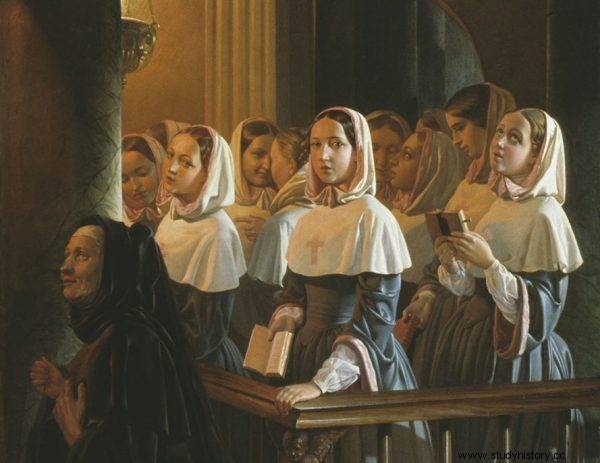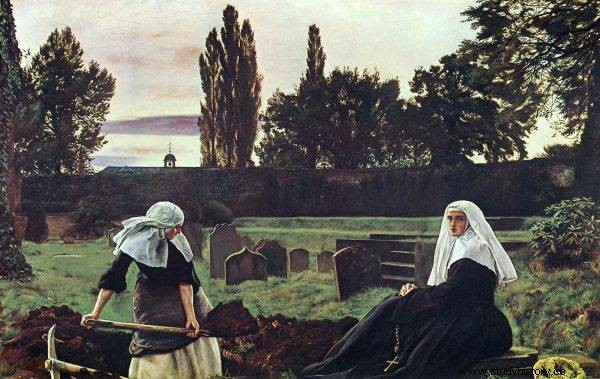The Catholic Church has had a strange approach to homosexuality for centuries. The case of 17th century lesbian nun Benedetta Carlini is a great example of this.
Homosexuality and the Catholic Church have had a strange relationship for centuries. On the one hand, it was considered a grave sin and persistently exterminated, on the other hand, from the very beginning it was present in various church institutions. Launched in theaters on January 7, Paul Verhoeven's new film "Benedett" inadvertently touches upon a theme that has long been an example of a specific approach of church hierarchs to issues related to sexuality. Namely, it is about homosexuality among women.
A long time ago in the small town of Pescia
Apart from the artistic level and scandalous form of the new film by the Dutch director, "Benedetta" is an interesting work in that it is based on an authentic and unique story. Bringing a nun to a church court, who was accused of having an intimate relationship with another woman, was a phenomenon that was practically absent in the chronicles until the end of the 16th century. We find only a handful of similar cases in the secular and church annals.
Judith Brown, the historian and author of the book on which Verhoeven's film was based, emphasizes, however, that the main reason Benedetta Carlini was indicted was not for the practice of lesbian love . Due to the apparitions and alleged miracles that happened to her, Benedetta gained adoration among the inhabitants of the Italian town of Pescia. She became the head of the Theatine Order located there and became a very influential person. Along the way, however, she fell into conflict with local hierarchs. And it was this fact, and not sodomy, that made the nun stand trial .

The main reason Benedetta Carlini was indicted was not for the practice of lesbian love (illustrative illustration).
The fact that rumors of her alleged sinful practices had flared up along the way worked only on the hand of the church authorities. If, however, the only offense of the nun was - as it was then called - "a sin against nature", the matter would most likely be swept under the rug, and we would never hear about Benedetta. This would happen because sexual acts between women were a topic that the Fathers of the Church had long ... eluded . Until the end of the 16th century, there were many, often conflicting, teachings that took the issue of lesbian love more or less seriously.
Book of Gomorrah
Church fathers have puzzled over the centuries how to accurately define sins related to sexuality. When it comes to female-female relations, dissertations on this subject were prepared, for example, by St. Augustine, St. Ambrose, St. John Chrysostom or St. Anselm. Medieval Christian philosopher Peter Abelard was to write that: He is against nature, that is, against the order of nature that created the female genitals [that they would be] for the use of men and vice versa, not so that women could live with women .
Earlier, St. Thomas Aquinas divided sexual sins into four categories:masturbation, zoophilia, sex in an unnatural position and homosexual act . This last point was particularly sensitive to the hierarchs. He was touching a problem that consumed many church institutions from the inside.

Lesbian love was treated as a sin of lesser caliber (illustrative illustration).
The sin of sodomy against men became one of the most heavily stigmatized crimes against divine law and was often punished with death. St. Piotr Damiani in his most famous theological treatise on this subject, the Book of Gomorrah, devoted practically all of his attention to male homosexual acts. Due to the lack of biological knowledge, it was believed then that in the act of conceiving a new life the man plays a more important role . The participation of women was considered to be less important. This has often been illustrated by comparing the ladies to "the soil on which the seed is thrown." His waste through all kinds of male homosexual acts was contrary to divine principles. Lesbian love, on the other hand, was treated as a sin of lesser caliber.
The gender issue
For a long time it has been held in Church teaching that women are far more prone to sexual promiscuity and debauchery. This is why, in times of witch hunts, they were accused of cooperating with Satan. It was also widely believed that only a man could arouse desire in both sexes. Women were denied this right. Therefore, feminine promiscuity was meant to apply only to male-female contacts. Sexual attraction between women, yes, there could be at times, but even when it was sinful, in most cases the fair sex was relieved and redemption took on a milder dimension.
For example, according to Theodore of Tarsus, the period of expiation for a woman who had intercourse with another woman was to last three years. The homosexual act between men deserved a ten-year penance. A similar distinction between the sexes among the sodomites was used by Gregory III . The period of penance for women was 160 days, and for a male homosexual act, compensation for sin was to last one year . It was only when the Counter-Reformation began in the Church that the punishments began to be leveled. Most often it was death.
In addition, it was widely believed that even when a woman makes love to another lady, she does so only to prepare for sex with the man.
A sin whose name is not pronounced
When things took a more serious turn and, as in the case of Benedetta Carlini, were based on an ecclesiastical judgment, there were also some differences. What distinguished the Italian nun's trial from generally accepted practice was that it was clearly announced that Benedetta was charged with the homosexual act.

To slander a nun before an ecclesiastical court, it would be enough to accuse Benedetta of having a relationship with one of the priests (illustrative illustration)
Usually it happened that if women were convicted of sodomy, then - unlike men - they were not made public for what exactly they were punished . This was done in order not to scandal among them. Being weaker and prone to debauchery, they were more suggestive and inclined to follow bad patterns by example. Lesbian love has thus become "peccatum mutum" - a sin whose name is not pronounced.
Behind the monastery walls
Coming back to Benedetta Carlini, is it possible that there is a grain of truth in the accusation of having sex with a confraternity? Such an affair could indeed have happened. To slander a nun before the church court, it would be enough to accuse Benedetta of having a relationship with one of the priests. You didn't have to make up a story about homosexual games. The truth of the theory of nuns' romance is also supported by the fact that since the late Middle Ages, women's orders gained a dubious moral reputation. More than places where the Word of God is contemplated, they have become a kind of storehouse for disgraced representatives of powerful families.

Since the late Middle Ages, women's orders have gained a dubious moral reputation.
In view of this state of affairs, it is obvious that there have been cases of loosening morals there. From the very beginning of the existence of female religious orders, the Fathers of the Church warned that:
The love you give one another should not be carnal but spiritual: because those things that are practiced by immodest women, even with other women, in shameful jokes and fun, should not be done even by married women or girls who are about to marry, let alone widows or pure virgins devoted to their holy vow to be the handmaids of Christ .
In the following centuries, in order to make it difficult for nuns to have intimate contacts, they were forbidden to sleep together and ordered to keep the lamps in the dormitories on all night. From the thirteenth century onwards, monastic rules usually urged nuns to stay away from their cells and leave the door open for the prioress to control. The reasons for the restrictions for nuns were usually hidden. Both inside and outside the monastery walls, however, it was an open secret why these rules were so strictly guarded.
Bibliography:
- Brown, Immodest Acts. The Life of a Lesbian Nun in Renaissance Italy , Oxford 1986.
- Boswell, Christianity, Social Tolerance, and Homosexuality Gay People in Western Europe from the Beginning of the Christian Era to the Fourteenth Century , London 1980.
- Cadden, Nothing Natural Is Shameful Sodomy and Science in Late Medieval Europe , Philadelphia 2013.
